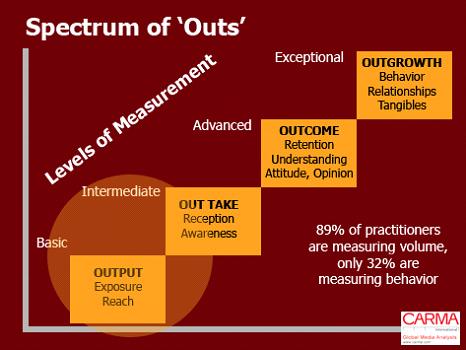Research IS measurement. Measurement IS research. The same techniques and tools. The same continuum. Different times, perhaps, but they are co-dependent and co-enablers. Using research in a pre-campaign, formative capacity can put us in a more measurement-friendly place post-campaign.
Among other things, pre-campaign research can help us set measurable objectives. Probably the most common objective in the hundreds of PR plans I’ve seen: Raise awareness. What’s rare, though, is to see a number attached to this objective. (Pre-campaign awareness can be tested overnight and for as little as a thousand dollars.)
Other objectives in a consumer MarComm context might include encouraging product trial (which is really about behavior change). Herein lies the paradox — a gap between objectives and the measures against those objectives.
Consider the Spectrum of ‘Outs’
Four increasingly sophisticated levels of whatever we want to do to an audience or whatever we want from them. There should be four corresponding and increasingly sophisticated levels of research and measurement to tell us whether or not we’ve met those objectives.
More often that not our communications plans have objectives to do with behavior change. But, as the slide below points out, only a third are measuring at that level. And we never will until or unless we put in place a pre- and post-campaign method and objective to work with.
Write Measurable Objectives
So we should write measurable objectives that:
- Include/refer to an outcome, not a tactic.
- Target an audience.
- Specify a finite time frame.
Example:
Increase awareness of Bell Canada’s new on-line security product by 15 percent among prospective clients within the Ontario market by the end of the 3rd quarter. (But even this is only a media relations, awareness-level objective.)
Presumably with the right measurement system in place, there’d be no question as to whether or not we hit our targets.
At Minimum, Measure by Tactic
Most measurement occurs at the tactical or communication vehicle level. We measure in often vague, relative terms. How much and how good — against ourselves, against competitors, compared to last time; a sort of binary up or down, this time and over time.
Ideally, Measure by Objective
However, ideally, measurement should be done at the objective level. This approach calls for evaluation against pre-set, measurable objectives in absolute terms. Did we meet our objectives or not?
Alan Chumley, senior consultant at CARMA International Inc., Global Media Analysts, has twelve years’ experience in the corporate communication / measurement industry, including senior-level, in-house corporate communications roles for leading blue chip organizations such as Bell Canada, as the director of Measurement for Hill & Knowlton, and vice president at Cormex Media Content Analysis. An advocate of driving science into the art of communications, Alan has extensive experience not only in corporate communications strategy and execution but also in the use of research and measurement to inform and influence traditional and social media content analysis. He specializes in interviews, focus groups, surveys, stakeholder relationship measurement, communication and perception audits, reputation research, employee engagement research, traditional and social media content analysis, and correlating this data with tangible organization outcomes. Connect with Alan and the CARMunity on Twitter and on LinkedIn.
Join Alan along with other volunteers of the PRSA National Capitol Chapter (PRSA-NCC) at the PRSA 2010 International Conference: Powering PRogress, October 16–19 in Washington, D.C.!








Alan,
A great post! We can’t emphasize enough about having measurable objectives.
However, I disagree about measuring at the tactical level. BOTH need to be measured. Why? Because tactics are where the money is spent and the only way to figure out the ROI of PR is at that level.
I can hear it now “PR doesn’t need to justify ROI, we aren’t marketing.” Not so fast… All money that is spent should be justified with a ROI. Whether we like it or not as PR practitioners, we do contribute to the bottom-line and that needs to be accounted for.
Sure, our PR objectives may not always be marketing or sales. For example, let’s pretend that an organization is boycotting the company we work for. Our job isn’t marketing, but building a relationship that allows us to develop a mutually understanding working relationship. If we come to a mutual agreement that backs them off and opens another avenue for people to buy, what’s that work worth?
Plainly said, it is PR’s job to ‘grease the skids’ so to speak for business to continue. There is a value and measurement that should be equated to both the objectives and tactics associated (i.e. short-term and long-term values).
Thanks for getting the ol’ wheels turning Alan!
Have a great weekend,
Beth Harte
Serengeti Communications
@bethharte
Thanks Beth.
Completely agree with you. I’m not sure I suggested to measure at only one level or the other. Both are important. Trouble is that all too often we stop at the tactical level.
Cheers
Alan
[…] c. be closely linked to overall organization/business objectives. […]